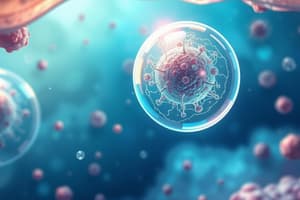Podcast
Questions and Answers
What is the formula for magnification?
What is the formula for magnification?
- measured size + actual size
- actual size / measured size
- measured size / actual size (correct)
- measured size - actual size
Which part of the microscope slide preparation acts as a stain?
Which part of the microscope slide preparation acts as a stain?
- The drop of water
- The iodine solution (correct)
- The cover slip
- The onion layer
What describes the process of osmosis?
What describes the process of osmosis?
- Movement across a permeable membrane
- Movement from high to low concentration
- Movement of water molecules to a less concentrated solution
- Movement of water across a partially permeable membrane from a less concentrated solution to a more concentrated solution (correct)
Where does gas exchange take place in the lungs?
Where does gas exchange take place in the lungs?
Which type of cell is characterized by the presence of a nucleus?
Which type of cell is characterized by the presence of a nucleus?
What phenomenon occurs when a potato cylinder is placed in a concentrated sugar solution?
What phenomenon occurs when a potato cylinder is placed in a concentrated sugar solution?
What is the correct order of events in the cell cycle?
What is the correct order of events in the cell cycle?
What is the primary function of ribosomes?
What is the primary function of ribosomes?
What is the main function of the cell membrane?
What is the main function of the cell membrane?
What feature do fish have to absorb oxygen from water?
What feature do fish have to absorb oxygen from water?
Flashcards
Magnification formula
Magnification formula
Measured size divided by actual size equals magnification.
Diffusion
Diffusion
Particles move from high to low concentration.
Osmosis
Osmosis
Water moves from low to high concentration through a membrane.
Active Transport
Active Transport
Signup and view all the flashcards
Alveoli
Alveoli
Signup and view all the flashcards
Villi
Villi
Signup and view all the flashcards
Eukaryotic Cell
Eukaryotic Cell
Signup and view all the flashcards
Prokaryotic Cell
Prokaryotic Cell
Signup and view all the flashcards
Cell Membrane
Cell Membrane
Signup and view all the flashcards
Osmosis experiment potatoes
Osmosis experiment potatoes
Signup and view all the flashcards
Study Notes
Diffusion
- Spreading of particles from high concentration to low concentration.
Osmosis
- Movement of water molecules across a partially permeable membrane from a dilute solution to a concentrated solution.
Active Transport
- Movement of substances against a concentration gradient (from low concentration to high), requiring energy.
Gas Exchange in Lungs
- Occurs in alveoli, which have a large surface area, thin walls, and good blood supply.
Small Intestine
- Covered in villi for increased absorption surface area and good blood supply.
Gills in Fish
- Fish use gills for oxygen absorption from water; gills have a large surface area.
Cell Structure
- Eukaryotic cells: Complex cells with a nucleus (e.g., animal and plant).
- Prokaryotic cells: Smaller cells without a nucleus (e.g., bacterial).
- Nucleus: Contains genetic material.
- Cytoplasm: Site of chemical reactions.
- Cell membrane: Controls what enters and leaves the cell.
- Ribosomes: Site of protein synthesis.
- Mitochondria: Site of aerobic respiration.
- Cell wall: Found in plant cells, made of cellulose, for support.
- Vacuole: Found in plant cells, contains cell sap.
- Chloroplasts: Found in plant cells, site of photosynthesis.
Stem Cells
- Adult stem cells: Produce certain cell types, found in bone marrow.
- Embryonic stem cells: Produce all cell types, controversial.
- Plant stem cells: Found in meristems.
Specialized Cells
- Sperm cells: Have a tail for swimming, many mitochondria for energy.
- Nerve cells: Long and branched for connecting to other cells and carrying electrical signals.
- Muscle cells: Can contract due to their long shape and many mitochondria.
- Root hair cells: Absorb water and minerals with their long, thin hairs and large surface area.
- Phloem cells: Transport sugars (plants).
- Xylem cells: Transport water (plants).
Cell division
- Cell cycle involves copying chromosomes, separating chromatids, and dividing the cell.
Studying That Suits You
Use AI to generate personalized quizzes and flashcards to suit your learning preferences.




